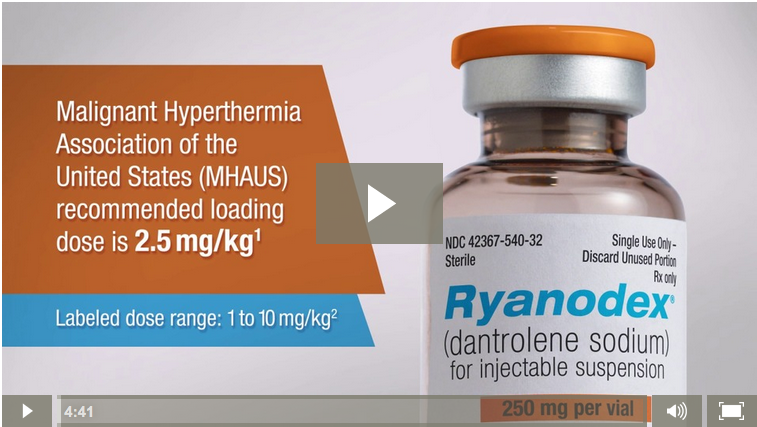![[Image: masthead]](/mhau001/includes/themes/MHAUS_2016/images/masthead/masthead-large.png)
Outside NA: 001-209-417-3722
FOR EMERGENCIES ONLY
Frequently Asked Questions

A list of the most frequently asked questions that we receive from both Medical Professionals and Patients.
Choose a specific category from the menu to filter the list of FAQs.
Category: Dantrolene
- Does MHAUS state a specific temperature range for refrigerated supplies for an MH Event?
-
MHAUS does not recommend a specific temperature range for refrigerated supplies. We recommend that each institution follow its regulatory guidelines for keeping medications and fluids refrigerated according to the appropriate temperatures. This would include regulatory agencies for hospitals, ambulatory surgery centers, and office-based surgery centers.
Watch this video FAQ for more information.
- How Does The Antidote Dantrolene Work?
-
Dantrolene is the only currently accepted specific treatment for MH. In an episode of MH, muscle metabolism is dramatically increased secondary to an increase in calcium within the muscle. This causes muscles to contract, ATP hydrolysis, and heat production. Dantrolene directly interferes with muscle contraction; decreasing calcium in muscle cells.
Dantrolene does not block neuromuscular transmission nor interfere with reversal of muscle relaxants. Although it does not block neuromuscular transmission, the mechanical response to nerve stimulation will be depressed, with subsequent potentiation of the non-depolarizing neuromuscular blockade. When dantrolene is used with non-depolarizing muscle relaxants, care should be taken to ensure muscle strength has returned prior to extubation.
Dantrolene may cause significant muscle weakness in patients with pre-existing muscle disease and should be used with extreme caution in those patients. Sterile phlebitis may follow administration of dantrolene, and should be infused through the largest possible vein. The sterile phlebitis can be later treated with warm soaks and elevation. When used with calcium channel blockers (verapamil or diltiazem), dantrolene may produce life-threatening hyperkalemia and myocardial depression. Otherwise there does not appear to be significant negative interaction with other drugs.
Once a patient has been successfully treated for 48 hours with intravenous dantrolene may be stopped and the blood tested daily until the CK level is trending down.
- Who Should Stock Dantrolene?
-
All facilities, including ambulatory surgery centers and offices, where MH triggering anesthetics (isoflurane, desflurane, and sevoflurane) and depolarizing muscle relaxants (succinylcholine) are administered, should stock dantrolene as indicated below, along with the other drugs and devices necessary to treat an MH reaction. If none of these agents are ever in use in the facility, then dantrolene need not be kept on hand.<
Succinylcholine is a potentially life-saving medication used to treat upper airway obstruction, and should be immediately available in any facility that administers anesthesia or sedative agents that have the potential to cause airway obstruction. In the absence of succinylcholine, practitioners should be prepared to administer an immediate-acting paralytic agent to treat life-threatening airway obstruction.
Watch this video FAQ for more information.
- Where Should Dantrolene Be Kept?
-
Dantrolene should be kept in or very close to the operating room, so that it is available immediately if MH occurs. Dantrolene may be stored at room temperature. A supply of sterile water for injection USP (without a bacteriostatic agent) should be kept nearby to mix with dantrolene before injection (60 ml/vial); the water for diluting dantrolene should not be stored in a refrigerator; it may be stored in a warming cabinet designed to maintain fluid temperatures between 35-40° C. All anesthesia and surgical team members should be aware of this location. NOTE: Dantrolene should not be mixed with any other diluent other than sterile water. The drug will not completely dissolve in crystalloid-containing solutions.
- How Quickly Must Dantrolene Be Accessible?
-
Dantrolene must be available for all anesthetizing locations within 10 minutes of the decision to treat for MH. Dantrolene must be available for all anesthetizing locations where MH trigger agents are used.” This is a slight modification of the current recommendation that the drug be available within five minutes because the five minute recommendation was not made based on consensus discussion and it is often not practical to have a large supply of dantrolene in every area where anesthesia is administered. For example anesthesia administration is now common in locations far from the operating rooms such as interventional radiology suites. This comment and others were made at the MH Hotline – Professional Advisory Council meeting held on May 14, 2011.
- Are There Any Advantages In Sharing A Supply of Dantrolene?
-
No. Minutes count in an MH emergency.
The Professional Advisory Council of MHAUS strongly recommends that an adequate supply of dantrolene be available wherever general anesthesia is administered. Responsibility for treatment rests with the facility where the surgery is performed. Sharing is not a good alternative.
- Can Warming the Sterile Water Facilitate Mixing?
-
Newer formulations of dantrolene are more soluble, making the warming of the sterile water unnecessary.
- What Is The Cost Of Dantrolene?
-
The cost of maintaining dantrolene in stock is a tiny fraction of most facility budgets and a very small price to pay for patient safety. By analogy, a cardiac defibrillator, a necessary emergency tool in all OR suites, is seldom used, and is paid for in time by each patient’s charges. In fact, many hospitals have 30-50 such units deployed at all times. Dantrolene, an emergency drug that is kept in only one location within most institutions, is an appropriate parallel to that situation and is relatively inexpensive when prorated.
*Contact manufacturer for current pricing. Although fulminant MH episodes are unusual, they do happen, and patients still die form MH. Remember that dantrolene is like a defibrillator; it is kept ready for use at all times, even though the need is rare. The cost can be prorated among all patients.
- Should MHS Patients Be Pretreated With Dantrolene?
-
Dantrolene prophylaxis is not recommended for most MH-susceptible patients. Dantrolene can worsen muscle weakness in patients with muscle disease and should be used with caution. Therefore, dantrolene prophylaxis may be omitted, provided non-triggering anesthetics are used, there is appropriate monitoring, and an adequate supply of dantrolene is available.
- How Much Dantrolene Should Be Kept On Hand?
-
To treat an MH episode, an initial dose of dantrolene at 2.5 mg/kg is recommended, with a suggested upper limit of 10 mg/kg. If a patient of average weight (approximately 70 kg) were to require dantrolene at the upper dosing limit, then at least 700 mg of dantrolene would be needed.
- DANTRIUM®/REVONTO® – stock a minimum of 36 - 20 mg vials
- RYANODEX®– stock a minimum of 3 - 250 mg vials
In addition, a review of cases has shown that in a “worse case” scenario of a very large person (i.e., about 100-110 kg or 220 – 250 pounds) having an acute MH incident, as much as 8-10 mg/kg will be needed for treatment; higher doses may be required on rare occasions.
This regimen of dantrolene will allow for initial stabilization and treatment while more vials are being acquired to continue treatment, as needed.
Watch this video FAQ for more information.
- Must we stock 36 vials of dantrolene if our OR is very close to a fully equipped hospital and the patient could be transported there quickly?
-
Yes, a stock of 36 vials is recommended. The patient experiencing an MH episode must be stabilized before being transported. Stabilization of an MH episode may take 30 minutes or more with multiple doses of dantrolene because, in some cases, MH progresses with explosive rapidity. The full 36 vials of dantrolene is inexpensive insurance against patient injury or death and a malpractice claim, which the facility will lose. The full 36 vials of dantrolene should be available within five minutes of the diagnosis of MH.
- What should we do with expired dantrolene?
-
We suggest the expired dantrolene either be used for your institution’s MH practice drills, or be mailed to MHAUS. Expired dantrolene received by MHAUS will be donated to simulation training centers for MH practice drills.
- Is dantrolene (the antidote for MH) considered safe to use in obstetrics should an MH episode occur?
-
While dantrolene can be given to a pregnant woman, it does cross the placenta and there are side effects in the neonate. This again is just a risk and would have to be weighed against the expected benefit. Weakness in the neonate might be expected and must be looked for and treated appropriately. An article published in 1988 suggests that at low dose, there are no problems. (Am J Obstet Gynecol., Oct 1988;159(4):831-4.
- How is Dantrolene Mixed?
-
MHAUS has provided videos that demonstrate how Dantrium® and Ryanodex® are prepared.
- Do I use "actual weight" or "ideal weight" to calculate dantrolene dosing?
-
MHAUS regularly receives inquiries regarding the appropriate first dose administration of dantrolene.
Our recommendation is a starting dose of 2.5 mg/kg intravenously based upon the patient’s true weight rather than ideal weight.
Although no scientific study has addressed the difference in this dosing recommendation, we believe the dosage based upon the patient’s true weight would achieve a more desirable concentration of dantrolene as it redistributes from the circulatory system to the intracellular tissue spaces of skeletal muscle where its major site of action is believed to occur.
Following the initial dose administration, if symptoms are not improving, continuing to administer up to 10 mg/kg is also recommended. This is not a ceiling dose, but just a guideline for initial administration.
We recommend contacting the MH Hotline during an emergency if further guidance or consultation may be helpful.


